Related Research Articles

The Northwest Territories is a federal territory of Canada. At a land area of approximately 1,144,000 km2 (442,000 sq mi) and a 2016 census population of 41,790, it is the second-largest and the most populous of the three territories in Northern Canada. Its estimated population as of 2021 is 45,515. Yellowknife is the capital, most populous community, and only city in the territory; its population was 19,569 as of the 2016 census. It became the territorial capital in 1967, following recommendations by the Carrothers Commission.
World music is an English phrase for styles of music from non-Western countries, including quasi-traditional, intercultural, and traditional music. World music's inclusive nature and elasticity as a musical category pose obstacles to a universal definition, but its ethic of interest in the culturally exotic is encapsulated in Roots magazine's description of the genre as "local music from out there".

The provinces and territories of Canada are sub-national administrative divisions within the geographical areas of Canada under the jurisdiction of the Canadian Constitution. In the 1867 Canadian Confederation, three provinces of British North America—New Brunswick, Nova Scotia, and the Province of Canada —united to form a federation, becoming a fully independent country over the next century. Over its history, Canada's international borders have changed several times, and the country has grown from the original four provinces to the current ten provinces and three territories. Together, the provinces and territories make up the world's second-largest country by area.
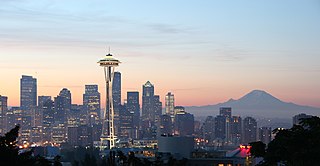
The Pacific Northwest is a geographic region in western North America bounded by its coastal waters of the Pacific Ocean to the west and, loosely, by the Rocky Mountains to the east. Though no official boundary exists, the most common conception includes the U.S. states of Oregon, Washington, and Idaho, and the Canadian province of British Columbia. Some broader conceptions reach north into Alaska and Yukon and south into northern California. Other conceptions may be limited to the coastal areas west of the Cascade and Coast mountains. The variety of definitions can be attributed to partially overlapping commonalities of the region's history, culture, geography, society, and other factors.

Edmonton is the capital city of the Canadian province of Alberta. Edmonton is on the North Saskatchewan River and is the centre of the Edmonton Metropolitan Region, which is surrounded by Alberta's central region. The city anchors the north end of what Statistics Canada defines as the "Calgary–Edmonton Corridor".
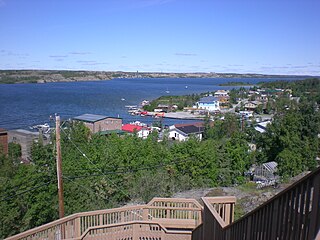
Yellowknife is the capital, largest community, and only city in the Northwest Territories, Canada. It is on the northern shore of Great Slave Lake, about 400 km (250 mi) south of the Arctic Circle, on the west side of Yellowknife Bay near the outlet of the Yellowknife River.
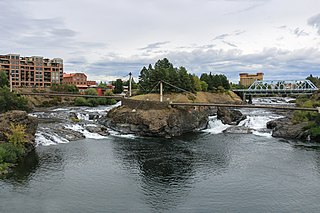
Spokane is the largest city and county seat of Spokane County, Washington, United States. It is in eastern Washington, along the Spokane River, adjacent to the Selkirk Mountains, and west of the Rocky Mountain foothills, 92 miles (148 km) south of the Canadian border, 18 miles (30 km) west of the Washington–Idaho border, and 279 miles (449 km) east of Seattle, along I-90.
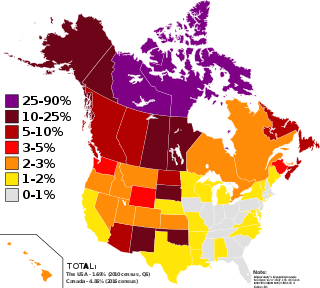
In Canada, indigenous groups comprise the First Nations, Inuit and Métis. Although Indian is a term still commonly used in legal documents, the descriptors Indian and Eskimo have fallen into disuse in Canada, and most consider them to be pejorative. Aboriginal peoples as a collective noun is a specific term of art used in some legal documents, including the Constitution Act, 1982, though in most Indigenous circles Aboriginal has also fallen into disfavour.
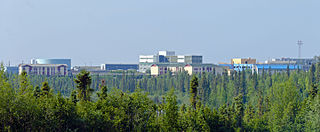
Inuvik is a town in the Northwest Territories of Canada, and hosts the regional office of the Inuvik Region. Inuvik is both a Gwich'in and an Inuvialuit community. The community, like Aklavik, is located in both the Gwich'in Settlement Area and the Inuvialuit Settlement Region.
Indigenous music of Canada encompasses a wide variety of musical genres created by Aboriginal Canadians. Before European settlers came to what is now Canada, the region was occupied by many First Nations, including the West Coast Salish and Haida, the centrally located Iroquois, Blackfoot and Huron, the Dene to the North, and the Innu and Mi'kmaq in the East and the Cree in the North. Each of the indigenous communities had their own unique musical traditions. Chanting – singing is widely popular and most use a variety of musical instruments.

The Massachusetts Museum of Contemporary Art is a museum in a converted Arnold Print Works factory building complex located in North Adams, Massachusetts. It is one of the largest centers for contemporary visual art and performing arts in the United States.
The Northwest Territories are a territory of Canada.

The Snowking Winter Festival is an annual festival held each March in Yellowknife, Northwest Territories, Canada since 1996.

Ulukhaktok is a small hamlet on the west coast of Victoria Island, in the Inuvik Region of the Northwest Territories, Canada.
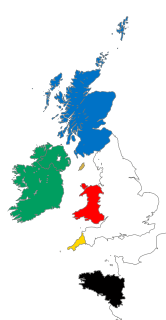
The Celtic nations are a cultural area and collection of geographical regions in Northwestern Europe where the Celtic languages and cultural traits have survived. The term nation is used in its original sense to mean a people who share a common identity and culture and are identified with a traditional territory.

Nunavut is the largest and northernmost territory of Canada. It was separated officially from the Northwest Territories on April 1, 1999, via the Nunavut Act and the Nunavut Land Claims Agreement Act, which provided this territory to the Inuit for independent government. The boundaries had been drawn in 1993. The creation of Nunavut resulted in the first major change to Canada's political map in half a century since the province of Newfoundland was admitted in 1949.
The Western Canadian Music Awards (WCMAs) are an annual awards event for music in the western portion of Canada. The awards are provided by the Western Canada Music Alliance, which consists of six member music industry organizations from British Columbia, Alberta, Saskatchewan, Manitoba, Yukon, and The Northwest Territories.
Contemporary Indigenous Australian art is the modern art work produced by Indigenous Australians, that is, Aboriginal Australians and Torres Strait Islander people. It is generally regarded as beginning in 1971 with a painting movement that started at Papunya, northwest of Alice Springs, Northern Territory, involving Aboriginal artists such as Clifford Possum Tjapaltjarri and Kaapa Tjampitjinpa, and facilitated by white Australian teacher and art worker Geoffrey Bardon. The movement spawned widespread interest across rural and remote Aboriginal Australia in creating art, while contemporary Indigenous art of a different nature also emerged in urban centres; together they have become central to Australian art. Indigenous art centres have fostered the emergence of the contemporary art movement, and as of 2010 were estimated to represent over 5000 artists, mostly in Australia's north and west.

Woodstock is a town in Ulster County, New York, United States, in the northern part of the county, northwest of Kingston, NY. It lies within the borders of the Catskill Park. The population was 5,884 at the 2010 census, down from 6,241 in 2000.
References
- ↑ "The Great Northern Arts Festival". greatnorthernartsfestival.org. Retrieved 18 May 2010.
- ↑ Thomas, Nancy; Rabinowitz, Ilana; Falick, Melanie (2002). A passion for knitting: step-by-step illustrated techniques, easy contemporary patterns, and essential resources for becoming part of the world of knitting. Simon and Schuster. p. 185. ISBN 0-684-87069-X.
- ↑ Grace, Sherrill E. (2001). Canada and the Idea of North. McGill-Queen's Press. p. 25. ISBN 0-7735-2247-6.
- ↑ "The Great Northern Arts Festival". yukoninfo.com. Archived from the original on 27 September 2011. Retrieved 18 May 2010.
- ↑ Beckett, Harry (2003). Nunavut. Eye on Canada series. Weigl Educational Publishers. p. 25. ISBN 1-894705-02-5.